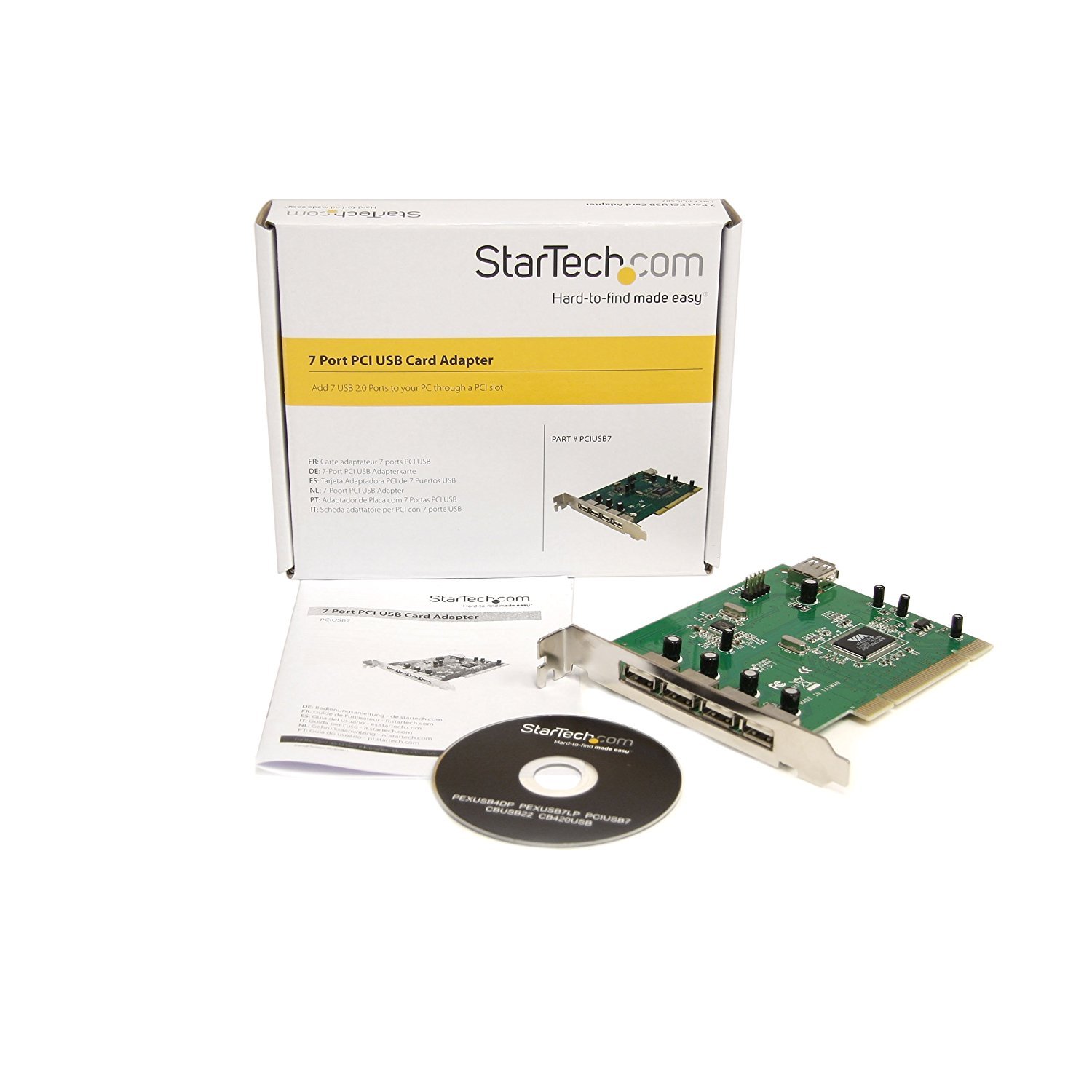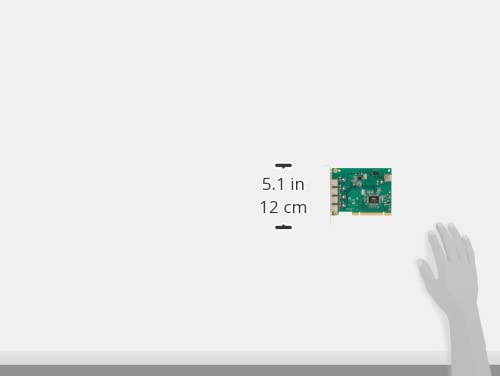Servicios al cliente
Sobre nosotros
Copyright © 2025 Desertcart Holdings Limited
Desert Online General Trading LLC
Dubai, United Arab Emirates




🚀 Unleash Your USB Potential!
The StarTech.com 7 Port PCI USB Card Adapter is a high-performance expansion card that adds 7 USB 2.0 ports to your PC, ensuring fast data transfer rates of up to 480Mbps and compatibility with older USB devices. With robust power delivery and compliance with industry standards, this adapter is perfect for enhancing your system's connectivity.


T**O
Zero issues, quick install, WinXP, PCI (not PCIe) socket, older motherboard.
EXECUTIVE SUMMARY: I had zero problems/issues installing this card under Windows XP Professional Service Pack 3, into a circa-2007 (Intel DP965LT) motherboard. Plug it in and go. The card I installed matched the pictures in this listing, bore a PCIUSB7 product label and had a VIA VT6212L chipset mounted on it. It was shipped and sold by Amazon (not a third-party) and arrived in the retail packaging/box pictured.THE DETAILS (FOR THOSE SEEKING DETAILS):There are other comments here about the board not fitting properly into the PCI socket. I had three (white) PCI sockets on this motherboard and had NO PROBLEM snapping this board into one of them. It fit quickly, perfectly and snugly. I suspect those having problems fitting this board to the socket are incorrectly trying to cram it into a newer standard PCI-Express (PCIe) socket. This board is designed to fit into an old-school (just) PCI socket. Unfortunate nomenclature perhaps, but PCI sockets and PCI-Express sockets are entirely different and the standards & sockets are NOT compatible. This MAY also be why you see a poster here or there speaking of frying/cooking/smoking onboard-sound or motherboards or whatever, in that they may have forced this PCI device into a PCI-Express socket, not knowing any better.There are other comments here about the PCI cover plate not fitting right, the top screw slot not lining up, having to bend the tang to get it to fit into the slot between the motherboard and the back of the case, the plate being too short, the screw holes preventing proper seating, the external ports not lining up correctly, etc. I did NOT HAVE ANY OF THOSE PROBLEMS with the card I received. YMMV … or perhaps those are historical manufacturing imperfections that have long since been resolved. Or perhaps, again, it may be someone who has forced this PCI device into a PCI-Express socket.I did NOT install any USB devices onto the StarTech board until AFTER I assured the StarTech board was properly installed. I did NOT update … or need to update the BIOS. I disconnected my Internet, so that no drivers would download without my knowledge, so I could be sure that the drivers that ended up being used were 'native.' (They were.)I booted the system. It POSTed and loaded Windows without issue. Once Windows was running, it displayed the scissors-looking "new device" icon in the system tray. Windows did NOT execute the "New Hardware Wizard" nor did it indicate it was doing anything about the device at all. After about one minute, that system tray icon simply disappeared.Then I confirmed the board was installed. I followed the path ControlPanel/System/Hardware/DeviceManager. At the bottom of the Device Manager list, under the heading "Universal Serial Bus controllers" the board could be seen to be using native Windows drivers (not previously observed in Device Manager): two instances of "VIA Rev 5 or later USB Universal Host Controller" and one instance of "VIA USB Enhanced Host Controller." (I uploaded a picture so you can see what I mean.)THEN I plugged in two USB devices (to the two lower external ports). They worked seamlessly. I did not test transfer speeds, but I'll know soon enough if there has been negative impact to speed.True plug-and-play. No BIOS update required. No driver download required. No system hangs experienced. No BSODs experienced.There was a (mini) drivers CD included in the box. The CD content is also available as a .ZIP download at the StarTech support page for this device. I downloaded it and the .ZIP file contains a .DOC file titled "Driver Installation Guide, Revision 2.1, 2003-05-26." The Guide states that the drivers provided are for use with Windows 98, Windows Me and Windows 2000. The Guide states that for Windows XP usage, Service Pack 1 is required, in order to obtain the required EHCI drivers. The Guide describes using the CD's XP Setup program that will 'install USB 2.0 host driver.' All that program really does is connect to the Windows Update website. That being moot, since the Windows Update server will no longer serve XP anyway. And, as described above, under XP Professional Service Pack 3, all the needed drivers are native. The Guide makes no reference to any Windows version above XP.This board claims to have seven USB ports. It DOES HAVE SEVEN PORTS. It has four external ports on the PCI faceplate … and three internal ports on the board. One of the internal ports is plainly an "ordinary" USB 2.0 female socket. But the board also has an internal 9-pin header that will accommodate TWO more USB devices. It only takes 4 pins to connect a USB 2.0 block plug. When you plug-in a 2x5 USB 2.0 block plug you are actually 'consuming' two 4-pin USB ports … even if the device does not appear to be using both of the ports.Some posters were confused about the 9-pin header. The 9th pin is simply there to make sure that a 2x5 block plug is oriented correctly; on the block plug the tenth 'hole' is sealed, so that means there is only one 'direction' in which the 2x5 block plug can be inserted down onto the 9-pin header. This is the only function the 9th pin serves. Again, it only takes 4 pins to connect-up a USB 2.0 device.Some posters reported troubles using the internal ports and/or the top external port. The way this board is 'organized' is that the four external ports are 'regular' USB ports. However, the top external port is being used as the 'provider' for a 4-port USB 2.0 hub … a hub upon which the three internal ports are mounted. Said another way, the three lower external USB ports each behave logically as an individual/dedicated port … but the top external port and the three internal ports are 'logically sharing' a single port. The "VIA USB Enhanced Host Controller" driver acts as a 'traffic cop,' prioritizing access among the four inputs to the hub's one shared port. This is why there are two instances of the "VIA Rev 5 or later USB Universal Host Controller" driver. One is driving the four external ports … then the other is driving the four ports on the hub.Said another way, data flowing through a port on the hub has to pass through three drivers, data flowing through one of the three bottom three external ports only has to pass through one driver.Accordingly, try not to have multiple 'data-intensive' devices sharing the ports on the hub, given they are actually/logically sharing a single port. And keep in mind that some devices just 'don't play nice' when being 'strung through a hub,' as they require a constant/direct connection to a port in order to perform correctly. This hub phenomenon MAY also explain why certain posters are complaining about reduced throughput speeds … in that they MIGHT be using a port on the hub while another port on the hub is also attempting some kind of throughput.Note this board appears to have one capacitor-per-port. That suggests solid electronic construction. I looked at photographs of other boards designed to do the same thing; many of them only had one capacitor, period. And this board has decent support/information at its manufacturer's website. That wasn't true of most of the other boards I looked at; the products seemed to be abandoned, missing a/o forgotten at their websites, with what's still selling likely to be just the last of new-old-stock floating around.CONCLUSION: A perfect board for easily adding USB 2.0 ports to your motherboard. IF you abide by the facts that (1) this board is only for (just) PCI sockets, (2) this board is primarily designed for older versions of Windows and (3) judicious/intelligent use of the ports that are involved in the hub is required. That is why this board has 100% 5-star reviews … among those reviews dated prior to newer versions of Windows and dated before wide-spread abandonment of (just) PCI socketry.
R**L
This card works well on my Windows 7 PC with an MSI motherboard
The product works well and does what it claims - it adds a total of 7 USB 2.0 ports, including 4 external USB A ports, one internal USB A port, and an internal header that will drive a pair of additional USB A ports (but you'll have to provide a card, front panel, etc. with those two ports and a header connector). I got the board primarily for the internal USB header, to drive the USB ports in a front panel, and it does that well. All of the type A ports mounted on the card also work as expected. There were no driver issues; the card was "plug and play" under Windows 7.The card provides more than adequate throughput for most USB 2.0 devices (printers, external devices controlled by USB, etc.). File transfer to flash media isn't particularly fast, but it's not painfully slow either (for USB 2.0). If you need fast data transfer to move large files, you should probably be looking for a USB 3.0 / 3.1 card instead.As some other reviewers have noted, the dimensions of the metal mounting / cover plate aren't quite right. Specifically, the screw tab on the plate aren't quite dimensionally correct so the mounting screw slot doesn't match up with the screw hole in the PC case. That means that I couldn't secure the card in place with a mounting screw. Fortunately, the card fits tightly into the PCI slot and the PC case and doesn't move when I plug or unplug USB cables, so it's not problematic for me. If I connected and disconnected USB cables regularly, however, I would be a little concerned about the card loosening in the PCI slot due to the force involved in plugging and unplugging cables.Overall, if you have a PC with an older motherboard that includes an open PCI (NOT PCIe) slot and you need a few more USB 2.0 ports, this card is probably the best option available. It isn't perfect, but it works fairly well and the price is very reasonable.
Trustpilot
Hace 1 semana
Hace 2 meses